Homemade Elderberry Syrup
This post may contain affiliate links. See my disclosure policy.
Elderberry syrup has been used as a natural remedy for centuries for treating and preventing colds, coughs and flu. This homemade Elderberry Syrup recipe is so easy to make yourself and is chock full of beneficial ingredients. Divide it up in smaller bottles and it makes also makes absolutely fabulous gifts for friends and loved ones!
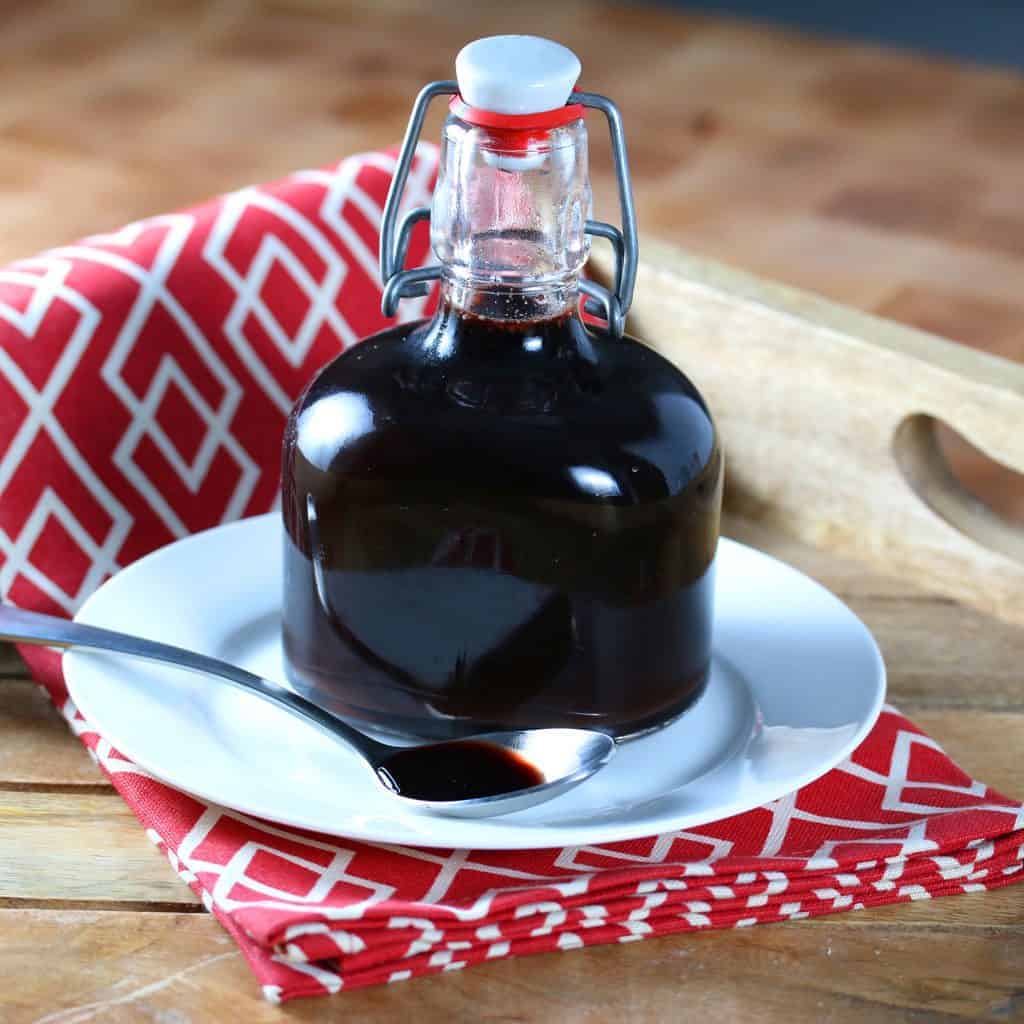
The elder tree (sambucus nigra) has been prized as a “medicine chest” for centuries because of its versatile applications. One of the most popular forms of elderberries is elderberry syrup. Today we’re going to show you how to make a potent homemade elderberry syrup – and it’s so easy!
Benefits of Elderberries
Black elderberries (sambuci fructus), the fruit of the elder tree, have been used both to prevent and treat the flu, common colds, coughs, sinus pain, back and leg pain, nerve pain, arthritis, inflammation, chronic fatigue, hay fever and have been shown to help prevent cancer and to significantly reduce the risk of dementia/Alzheimer’s.
Elderberries are a natural anti-inflammatory and are particularly high in flavonoids (plant-based antioxidants) – higher than blueberries, cranberries, blackberries and goji berries – and these flavonoids are known to help prevent damage to the body’s cells and boost the immune system. They’re also high in vitamin A and with the exception of rose hips and black currants are thought to have the highest levels of vitamin C.
Quite simply, blackberry syrup is pretty awesome stuff!

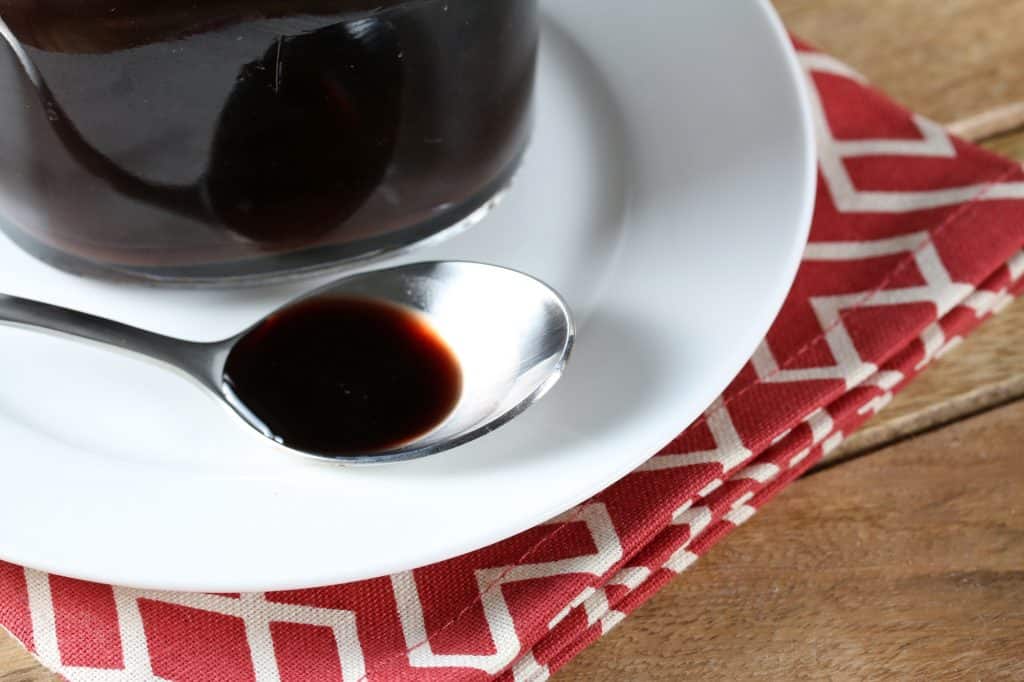
Growing up my mom would regularly brew up natural home remedies when my brother and I had colds and coughs and they always served us well. Elderberry syrup was one of them. While conventional drugs certainly have their place, I’ve always been one who turns to them as a last resort, after I’ve first tried more natural, holistic options.
Elderberry syrup is an age-old elixir that has been used for thousands of years for both treating and preventing the illnesses that commonly accompany the cold weather: Coughs, colds, and the mild flu.
Elderberry Syrup Ingredients
This homemade elderberry syrup also incorporates therapeutic doses of ginger, cinnamon, clove and raw honey for added fighting power and protection. Ginger has been used for centuries to relieve sore throats, alleviate congestion, soothe upset stomachs, and to promote sweating to eliminate toxins in the body. Cinnamon is an antioxidant-rich warming spice that helps fight infections and viruses and boosts the immune system. Cloves are a natural antiseptic and analgesic, which help eliminate and prevent the spread of germs and provide relief for sore throats. Cloves also act as an expectorant, making it easier to cough up phlegm. Raw honey has antimicrobial and antiviral properties that inhibit the growth of microbes and fight bacterial infections as well as inhibit viral activity. It’s also an effective cough suppressant, soothes sore throats and is a natural sleep aid, especially in children. If you can find it, raw buckwheat honey has the highest level of antioxidants.
How To Use Elderberry Syrup
There is no standard dose for elderberry syrup. Adults trying to prevent a cold or flu can take 1 tablespoon 3-4 times a day and increase it to 2 tablespoons 3-4 times a day to treat a cold or flu until the symptoms disappear. Decrease the dose for children. If giving it to children it’s always recommended to first consult your pediatrician. Note: The American Academy of Pediatrics recommends not giving raw honey to infants under 12 months.
Should I Use Dried or Fresh Elderberries?
The easiest form of elderberries to use for making syrup is dried. They store well and you can conveniently grab them as needed to make small batches of syrup that will remain fresh and potent before you need to make another batch. Of course if you have access to fresh elderberries feel free to use those.
I use and recommend Frontier Organic Whole Elderberries.
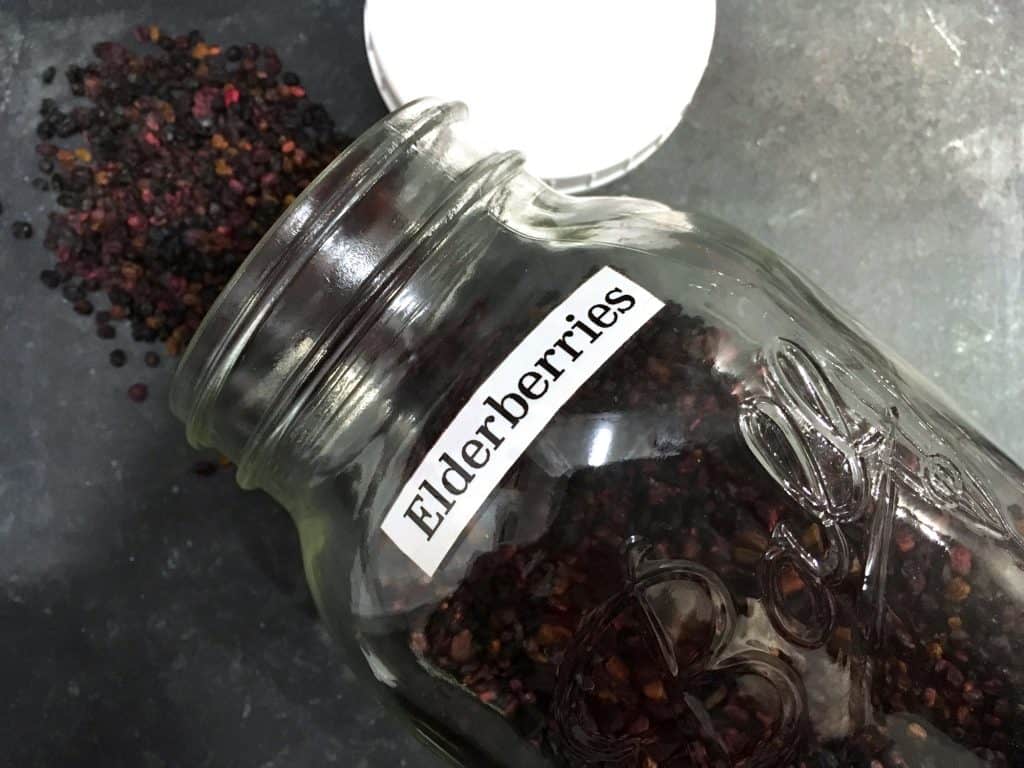
Elderberry Syrup Recipe
Let’s get started!
Place the dried elderberries, diced ginger, ground cinnamon and ground cloves in a small saucepan.
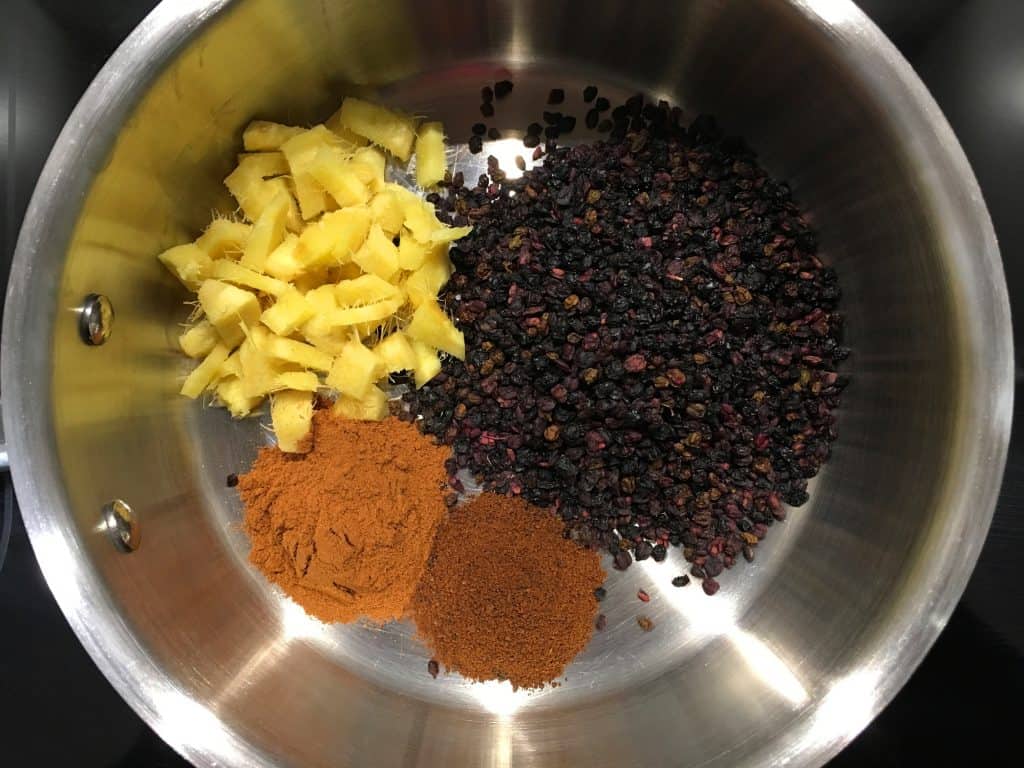
Add the water and bring to a boil. Reduce the heat to a low simmer and simmer uncovered for approx. 30 minutes or until the liquid is reduced by roughly half (this isn’t a must). Use a fork or potato masher to mash the berries.

Let the mixture steep for a few minutes and then strain the liquid through a fine sieve or cheesecloth and mash or squeeze the solids to release as much liquid as possible. Let the liquid cool until room temperature (no hotter than lukewarm) and then stir in the honey. Makes about 3 cups.
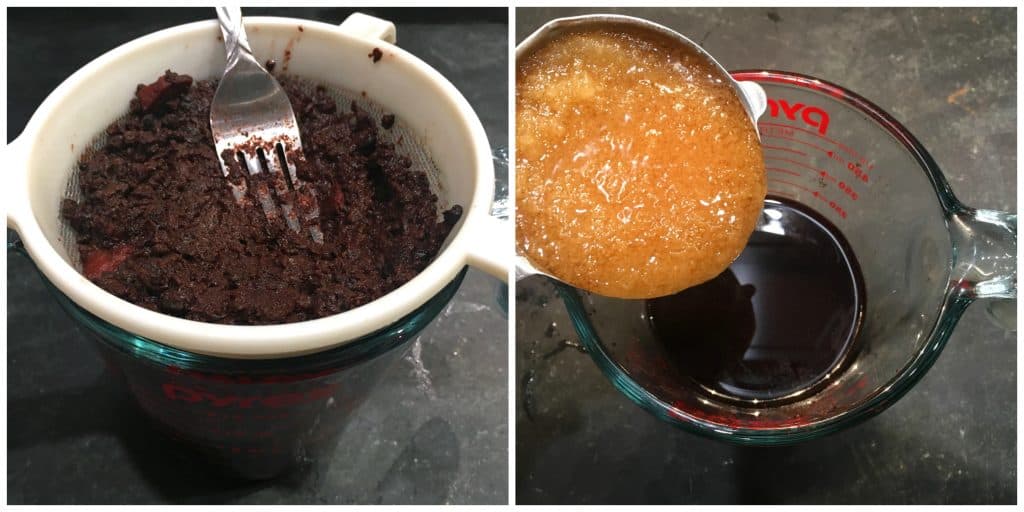
Store in the refrigerator. Will keep for at least 2 weeks.
Here’s to good health!
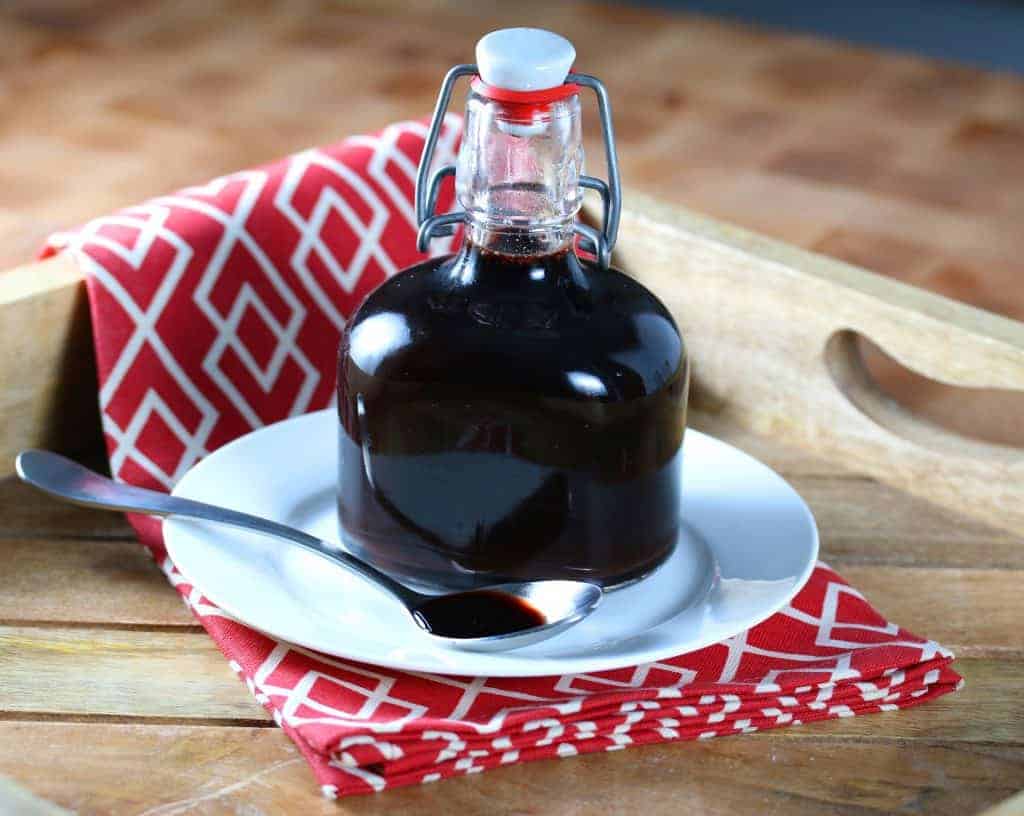
And for a syrup that’s more a dessert than a medicine, be sure to try our homemade Blackberry Syrup!
Save This Recipe
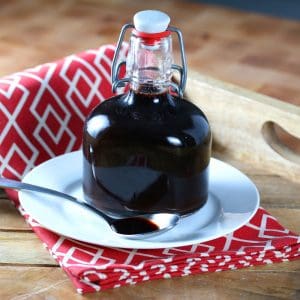
Homemade Elderberry Syrup
Ingredients
- 1 cup quality dried elderberries
- 1/2 cup chopped fresh ginger, peeled
- 2 tablespoons ground cinnamon
- 4 teaspoons ground cloves
- 4 cups water
- 1 cup raw honey, local if possible (use raw: non-raw is simply sugar with no health benefits) (raw buckwheat honey has the highest levels of antioxidants)
Instructions
- Place all of the ingredients, except for the honey, in a small saucepan. Bring it to a boil then reduce the heat to a low simmer and simmer uncovered for approx. 30 minutes or until the liquid is reduced by roughly half (though that much isn't necessary). Use a fork or potato masher to mash the berries.
- Let the mixture steep for a few minutes, the strain the liquid through a fine sieve or cheesecloth and mash or squeeze the solids to release as much liquid as possible. You can also use a food mill. Let the liquid cool until room temperature (no hotter than lukewarm) and then stir in the honey. Makes about 3 cups.
- Store in the refrigerator. Will keep for at least 2 weeks.
- There is no standard dose for elderberry syrup. Adults trying to prevent a cold or flu can take 1 tablespoon 3-4 times a day and increase it to 2 tablespoons 3-4 times a day to treat a cold or flu until the symptoms disappear. Decrease the dose for children. If giving to children it’s always best to consult your pediatrician.IMPORTANT NOTE: The American Academy of Pediatrics recommends not giving raw honey to infants younger than 12 months.
Nutrition
Originally published on The Daring Gourmet January 13, 2018



















Does seem to help a lot. I put mine in a blender before straining. Am thinking of adding erythritol this time for known antiviral effects.
hi, thanks for this lovely recipe!
does it work with sugar too, if yes, how much to use please? I use raw berries.
2.how come many recipes cook them for a lot longer?
3.what is the maximul they can b kept in the fridge for?
Many thanks!
Do you just toss out that elderberry goodness that you squeeze the liquid out of? It seems like such a waste and it smells so good.
Hi Britanni, they have hard, gritty centers and so don’t really have a good culinary use after they’ve been cooked for the syrup. If you can think of some way to utilize them by all means do. I just add them to my compost pile for my garden.
Use as microwave freshener. Put the smell-good in a small bowl add a tablespoon of vanilla 1/4 cup water and heat for 2 minutes. 😊 smell up the kitchen and most of the house. ❤
That’s a fun and unique idea, Ruby, thanks for sharing!
We feed all our fruit pulp and peels to the chickens. Keeps them healthy and boosts egg nutrition.
Where did you get your short swing top bottle?
Hi! I made this elderberry syrup and mine didn’t quite come out to 16oz. It probably filled my jar 3/4 the way up. Any suggestions?!
Hi Carly, the amount will vary depending on how much of the liquid evaporates while it’s simmering and a lot of factors will determine that (how long it simmers and at what temperature, what kind of saucepan you’re using, what the diameter of the saucepan is…).
Due to the cyanogenic compound, it is recommended that the elderberries simmer for 45-60 minutes once they have come to a boil. A friend was given elderberry syrup last January by a neighbor. Flu was circulating in her daughter’s daycare, so she and her 4 year old began taking prophylatically. Both became violently ill, puking all night. Thinking they’d come down with a but, they stopped taking the elderberry syrup. Within 24 hours, they both felt much better. A couple weeks later, my friend began experiencing respiratory symptoms and started taking the elderberry syrup again. Once again, she spent the night vomiting. She asked her neighbor for the recipe and learned she had only processed the elderberries for 30 minutes. My friend now avoids elderberry syrup like the plague, even after learning it must be processed longer to deactivate the cyanogenic compounds.
The moral of the story is add 15-30 minutes to your boil time to avoid any issue you may encounter with vomiting. Some people are more sensitive than others, for sure. But, I prefer not to take the risk with my family.
Hi Janet, I’d like to see the research that measured cyanogenic glycosides levels at multiple time intervals during the cooking process. I’m pretty confident you won’t find any. That 45-60 minute figure is purely arbitrary.
The fact is, these same cyanogenic glycosides are found in over 2500 species of edible plants, including grocery staples like apples, apricots and plums which are virtually never cooked before consumption. Furthermore the level of cyanogenic glycosides in many grocery store staple fruits is even higher than those found in elderberries. So if what you’re saying is truly the case, these individuals who are sensitive to this compound would be vomiting after every apple eaten and the FDA would have long before now started including warning labels on our produce. I don’t know what triggered the vomiting in your friends but I have a hunch there was something else going on. But certainly, if something doesn’t agree with your system – whether it’s elderberries, apples or apricots – stop eating it.
They had this reaction because they used fresh berries. Never ever ever use fresh berries always dried. 25 year Herbalist.
And there are studies. Again, NEVER ever use fresh berries or you too will be vomiting your guts out.
My daughter fresh elderberries and has never had any issues. She says the syrup is much tastier I might add
Thank you for sharing this. I always brewed mine for 45-60 mins.
Does it matter if you added the honey in the beginning before you put it in the stove to boil and simmer
Hi Elizabeth, yes it does. If you’re using raw honey (which is what is recommended) it’s high in antioxidants, antimicrobial and antiviral properties that inhibit the growth of microbes, fight bacterial infections, and inhibit viral activity. Heating the honey will kill these healthful properties so that it is why it should be added at the end after the syrup has mostly cooled down.
Has anyone used ground ginger instead of fresh? How much do u use?
The conversion for grated fresh ginger to ground dried ginger is 1 tablespoon fresh to 1/4 teaspoon dried. I use dried in my elderberry syrup. For 1/2 cup, I think that would be 2 teaspoons.
Super simple to make depending on the ingredients I have on hand.. I make all versions of this syrup My families favorite way is Jell-O shots….absolutely any flavor works!As how I judge how long to take it is all the months kids are in school is how long we take it but when they are on summer break and we’re all outside a lot we don’t take it
Hi! Does the liquid have to be reduced by half? I am multiplying the recipe to make a lot but the liquid is obviously not reducing by half with larger portions. Is that part necessary? Letting it simmer for 1.5 hours or so
Hi Rach, no it’s not necessary at all. It’s already a very concentrated syrup, more potent than the stuff you’ll find in the stores.
Dear Kimberly;
I just wanted to post how awesome I think you and your recipes are!! I absolutely adore your website. This elderberry recipe is the
icing on the cake!!!
Thank you so very very much for all your astonishing recipes that are just as authentic and one of a-kind as I imagine you must be.
Blessings to you and your family,
Thanks so much for such a kind and generous compliment, Donna! Blessings to you and yours also :)
Thanks for the info
Hi Kimberly, the jug with the locking swing top in the 1st photo; what size is it and where does one get it? I would love to have one.
Hi Albert, I’m trying to think where I got it and I can’t remember. At first I was thinking maybe IKEA (I have some similar bottles from IKEA) but I’m not sure. Sorry! :(
I found 18oz glass flip top bottles at the dollar tree. They are also on dollar trees website for order.
Tis the season where we need all the help we can get! Thank you so much for sharing!
I too prefer tried and tested home remedies than the store bought cough syrups.